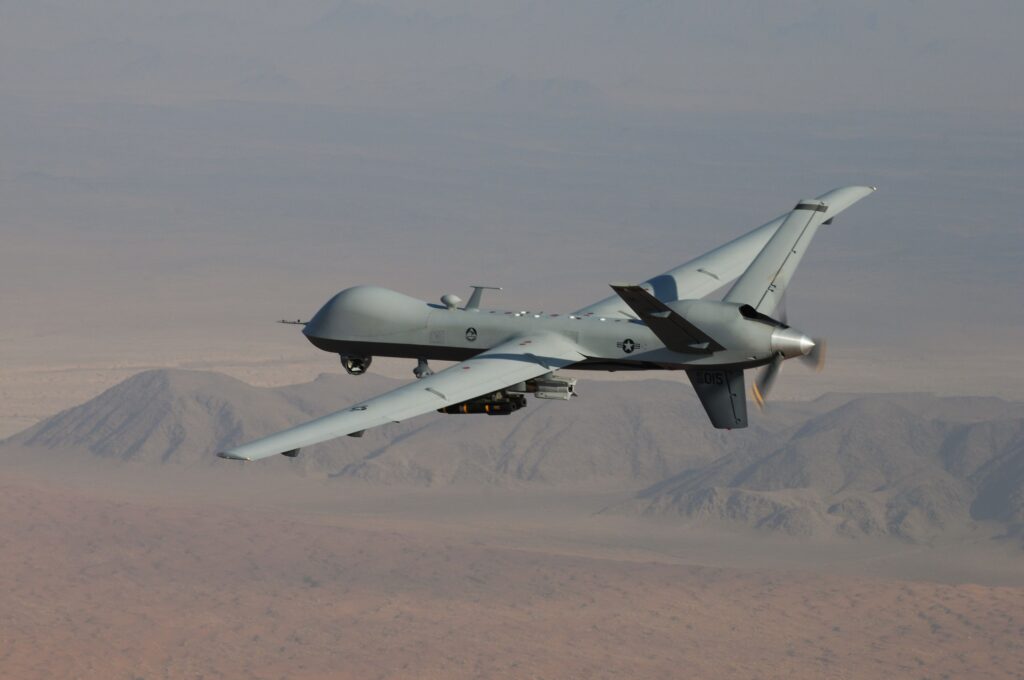Persistent Regional Drones Could Deter China, Russia: CSBA

MQ-9 Reaper
WASHINGTON: A coherent US and allied strategy to increase the use of drones in regional hot spots could serve as a strong deterrent to gray-zone aggression by Russia and China, says a new study by the Center for Strategic and Budgetary Assessments (CSBA). Implementing a new strategy, which CSBA calls “deterrence by detection,” would cost about $1.4 billion annually, the study says.
The study argues that US armed forces are poorly configured to handle potential regional aggression by Russia in Western Europe and by China in East Asia, where both countries are “developing the ability to launch aggression rapidly against states on their periphery under the cover of increasingly capable reconnaissance-strike networks.”
Currently, the CSBA study finds, “With only limited warning, Beijing or Moscow could exploit their
time-distance advantage to seize allied territory before the United States and its allies could
respond, thereby creating a fait accompli that would be difficult to reverse after the fact.”
However, DoD does have enough capability by using long-endurance, non-stealthy unmanned aerial systems (UAS), to deploy a persistent “eye in the sky” capability that could reduce the likelihood of either nation pulling off such a stealthy coup. The study, called “Deterrence by Detection: A Key Role for Unmanned Systems in Great Power Competition,” argues that all is needed is for the Pentagon to develop “new concepts of operations and organizations to employ those capabilities effectively.”
The study lists the following systems as relevant to such a new strategy: Air Force MQ-9 Reapers and RQ-4 Global Hawks, Navy MQ-4C Tritons, and Army MQ-1C Gray Eagles.
Such a new employment concept for UAS would be enhanced by finding ways to allow allied and partner nations to participate coalition operations that could offset US costs, the study finds.
“Real-time situational awareness is critical to countering the twin challenges of sub-conventional gray zone aggression and a conventional fait accompli gambit promptly and effectively,” the study explains. “UAS conducting ISR missions could provide increased warning of a pending Chinese or Russian attack, thereby helping to ensure that forward postured forces are prepared to respond decisively. By increasing warning time, UAS would help mitigate the United States’ time-distance disadvantage, thereby allowing the United States and its allies to mass sufficient combat power to prevent a fait accompli.”
It identifies three priority areas in the Asia-Pacific and three in Europe that CSBA says are best suited for long-endurance unmanned aerial reconnaissance: the Taiwan Strait, South China Sea and East China Sea in the Asia-Pacific, and the Baltics, Black Sea, and eastern Mediterranean Sea in Europe.
CSBA analysis shows that implementing “deterrence by detection” in those priority areas would “require 46 airframes in the Western Pacific and another 46 in Europe, or a total of 92 aircraft.”
“The United States and its allies and partners could meet the inventory requirement by shifting existing aircraft from other theaters and missions to the Western Pacific and Europe and by assigning some of the aircraft the United States is already procuring to new missions,” it explains.
The authors — CSBA President Thomas Mahnken, Research Fellow Travis Sharp, and Senior Analyst Grace Kim — estimate annual operating costs for those 92 drones would total about $1.4 billion per year, based on Congressional Budget Office figures.
“Since the aircraft would come from the existing inventory, not from new purchases, the operating cost represents money DoD would have spent anyway to keep the aircraft flying (assuming it kept them flying). For this reason, implementing ‘deterrence by detection’ should not require any spending increases,” the study explains.
The study finds that the strategy would tie up only “14 percent of the Air Force’s MQ-9 Reapers, 38 percent of the Navy’s MQ-4C Tritons, 53 percent of the Air Force’s RQ-4 Global Hawks, and 6 percent of the Army’s MQ-1C Gray Eagles.”
“Indeed, a virtue of the concept is that it employs capabilities that the United States already possesses but that have been underutilized in the context of great-power competition because their value in that context has not been appreciated,” the study concludes. “Contributions from allied countries would reduce the burden on the U.S. military and free up UAS for other missions while enhancing allied capabilities.”